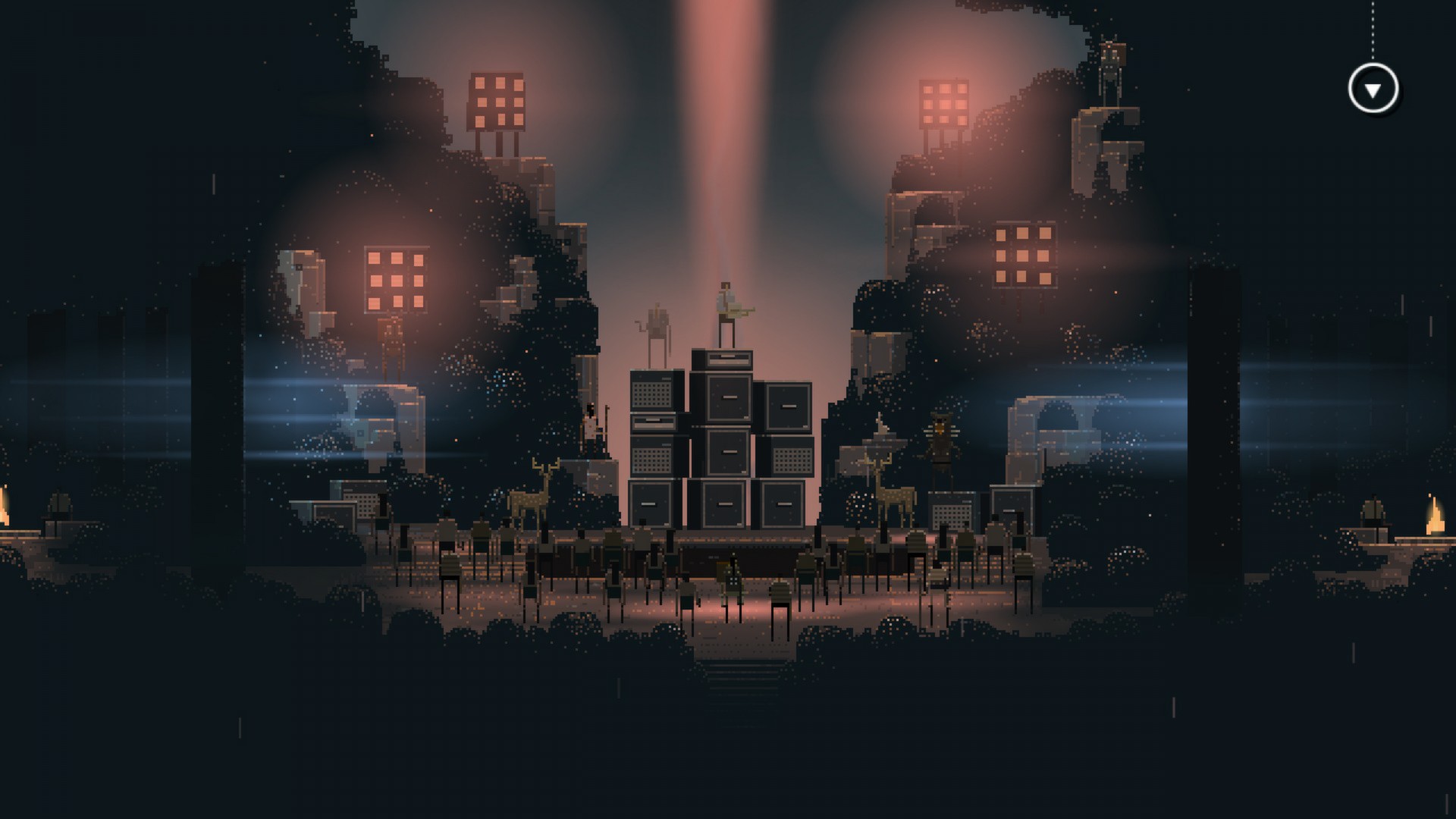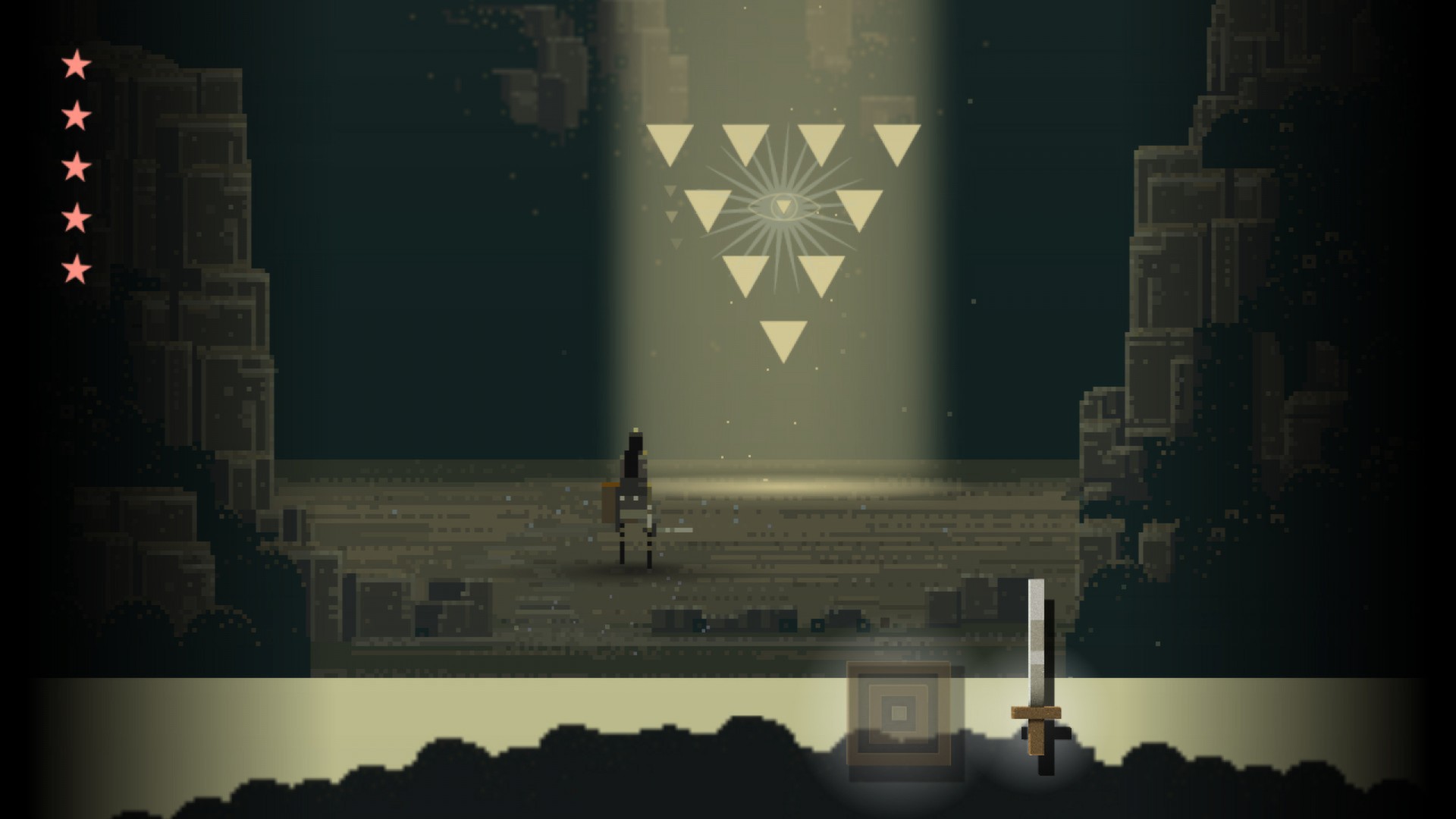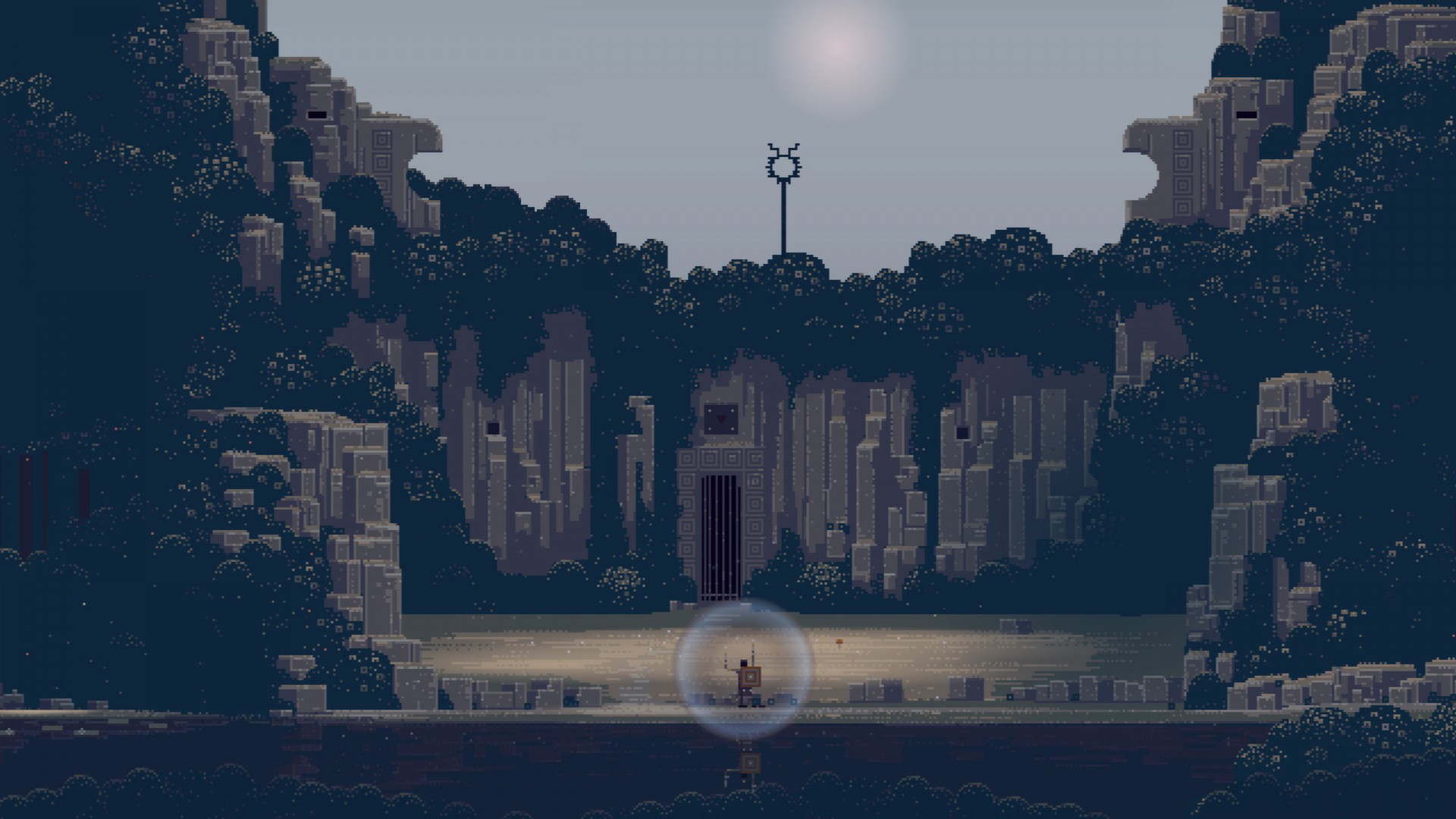Superbrothers: Sword & Sworcery EP is an exploratory action adventure with an emphasis on audiovisual style. Traverse a mythic little realm, use a sword to do battle & evoke sworcery to solve mystical musical mysteries. Co-operate with friends via Twitter, experience a videogame world that is affected by moon phases & help a wandering warrior monk complete her woeful errand.
Superbrothers: Sword & Sworcery EP features an album's worth of original music by noted composer Jim Guthrie as well as artwork & designs by Superbrothers Inc, crafted & engineered by videogame wizards at Capy in Toronto, Canada.
Songs will be placed in your Superbrothers: Sword and Sworcery EP Folder in the Steam Directory:
...Steam/steamapps/common/superbrothers sword & sworcery ep/soundtrack
Key Features:
- Guide a warrior monk on a laid back adventure in a bronze age mountain wilderness, overcome occasionally hard-hitting battes & solve mystical musical puzzles to help The Scythian complete her woeful errand.
- A fevered famicom dream. Explore a lavishly-painted mythopoetic storyworld affected by real-world moon phases, conceived & crafted by a representative at Superbrothers Inc.
- A prog rock concept record you can hang out in. Treat your ears to an album's worth of original music created by the legendary composer Jim Guthrie.
- Remastered & ready for public exhibition. The new edition features razor-sharp pixels and a refined audio mix, ideal for projecting in a home theatre or cinema context.
- Point & click. This new edition of S:S&S EP for the electric computer has been faithfully re-engineered by videogame wizards at Capy to support input via the two-button mouse.
- Tweet this? Optionally co-operate with friends via Twitter by relaying clues & other tidbits as you dig deeper into the esoteric mysteries of S:S&S:EP.
Soundtrack Details:
Jim Guthrie's legendarily epic Sword & Sworcery LP: The Ballad of the Space Babies is a landmark prog rock concept album from the noted composer. Jim's compositions were named "The Best Videogame Music of 2011" by Kotaku, while Double Fine's Tim Schafer said "The music is amazing. I want Jim Guthrie to score my life."
Track List:
- Dark Flute 02:40
- Lone Star 02:35
- Doom Sock 02:35
- The Prettiest Weed 02:19
- The Cloud 03:50
- Under A Tree 05:03
- The Maelstrom 01:56
- The Ballad Of The Space Babies 03:06
- Unknowable Geometry 04:02
- Bones McCoy 02:06
- Ode To A Room 01:43
- The Prettiest Remix 00:56
- The Whirling Infinite 02:30
- Little Furnace 03:25
- Bonus Track Intro 00:01
- Cabin Music (Bonus Track) 02:39
- Battles 1(Bonus Track) 00:48
- Battles 2 (Bonus Track) 00:35
- Com64 (Bonus Track) 01:21
- Mushrooms (Bonus Track) 02:15
- Death To Everyone (Bonus Track) 01:13
- Confronting The Wolf (Bonus Track) 01:20
- Up A Mountain (Bonus Track) 01:28
- Activating Trigons (Bonus Track) 01:23
- How We Get Old (Bonus Track) 05:21
- And We Got Older 04:47
- Bonus Track Outro 00:02


Imagine: it's 2013, you're a small team, you've previously made a small but well-regarded game, something like Superbrothers: Sword & Sworcery EP just to choose a random example, and now you're swinging for the bleachers with an ambitious new design.
You and a pal have been cooking up a science fiction videogame where you explore a planet and survive from two perspectives: you can walk around and talk to people, then you get in a jett and you can zip around the planet's surface, gathering things and figuring things out in an interesting wilderness built with procedurally-placed ecosystem tools.
Now, imagine you tune into a 'The Game Awards' type broadcast (the last of the VGAs?) in late 2013, and you see this:
https://www.youtube.com/watch?v=aCgWabJssVI
Whatever you may think about No Man's Sky, there's no getting around the fact that from that first trailer, it has drawn a high level of attention.
So, back to imagining you and your small team and your 'walk around a bit and then get in a jett and zip around a mostly procgen game-world gathering and crafting things' videogame. Well, now might be time for a little reflection, to tease apart how your vision aligns, and where it contrasts, with the new 800-pound gorilla in this genre.

We kept on with our vision for JETT through 2014 and into 2015, with all its Monster Hunter and Metroid Prime -inspired nuances and wrinkles, getting to know what we could and couldn't do with procedurality.
https://store.steampowered.com/news/app/1761600/view/6926004339899510462

We were working through designs that involved gathering and crafting, and figuring out what kinds of scenarios could hold people's attention, while we kept the focus on the science-discovery angle and attempted to side-step the usual extract-gather mechanics.

We had our Destiny-inspired menu system up and running, and when we saw that's what Hello Games was up to with No Man's Sky we felt ah well, yep, that makes sense.

In the wake of No Man's Sky emergence, attention was drawn to the enigmatic singularity of procedural generation through 2014 and 2016, the whizbang of it and the endless possibilities and such, and I found myself remembering playing and enjoying Frontier: Elite II back in the day, a miracle-work in hyper-ambitious interstellar procgen that ably demonstrated to me both the allure and some of the limits of this approach.
Once the whizbang of procgen wears off, you've got to actually play the videogame: to get a grip on the controls and comprehend its systems and find them interesting or meaningful, and find a groove in its rhythms and patterns. In any case, at length I had to admit that Frontier: Elite II was just not my cup of tea.
Still, Frontier: Elite II is absolutely worth a look-see, if you're unfamiliar!

https://www.youtube.com/watch?v=jJdz7x9hpUA
My most vivid positive memory of playing Frontier involved parking at a base on a moon in orbit around a gas giant, then ratcheting up the flow of time x10 and watching a cosmic ballet unfold before my eyes, with the moon I was parked on wheeling around the gas giant, day turning to night, the stars in the heavens whirling, every start representing a potential destination, and with the other moons and planets in the surrounding solar system visible in the distance, moving in their orbits. Magnificent! (FWIW: My least positive memories of playing Frontier tended to involve me setting a destination, setting a course, switching on my autopilot, ratcheting up the flow of time and kicking back.... and then suddenly colliding with an unseen planet or somesuch. Alas, haha.)

With my Frontier: Elite II experience in mind, and my 'proc-gen is an endless miracle' expectations securely in check, I'll admit that I found a great deal to appreciate in the vibe, style and craft of No Man's Sky when it shipped in 2016. Those colors! That music! The pizzazz! It's a pretty magnificent thing, no doubt. Still, as anticipated, I struggled to find my footing in the actual videogame experience.

For one thing, I learned that as player, I tend to prefer experiences that are more curated and feel contained and completable, even if they feel vast at times. Or, put another way, from a designer's point of view, I identified that my player type, whatever type that is, needs an immediately engaging on-ramp -- hook me!! -- and then I need some meaningful-to-me structure to motivate my continued engagement, and ideally at some point I could use some characters to start to relate to and begin to care a bit about. These reflections helped me recalibrate my feelings about what JETT could and should be.

Something else I spent a lot of time considering relates to the underlying narrative/mechanics in science fiction / space fantasy exploration games.
As a teen I was so blown away that Frontier: Elite II contained a universe at just ~500K, and I recall having no particular qualms with how vacant and colonial everything was. The narrative premise seemed in-line with 50s and 60s science fiction, the kind probably written by European white men, authors like Clarke and Asimov that I had been reading at that time. In the 90s, the deeper scrutiny of 'explore/conquer/extract' fantasies hadn't reached many teenager's bedrooms, or at least it wasn't particularly itchy to me at the time.
However, as an adult in the 21st century, a witness to the impacts of our civilization and its values, I've found that I struggle to resonate with stories and designs that replicate and dress up those capitalist/colonial concepts. I get that there's a reason our species enjoys these types of activities, and that these designs are reliable in videogames; but for me, I can't help but ruminate regretfully that this is the case.
As we carved out JETT's cosmology, we talked about how it might stand as an interesting work of science fiction, something that could soar with spectacle and escapist thrills, hit notes of awe and dread, and carry within it a story that involves characters who represent the best of us, within a reasonably enlightened and thoughtful culture, struggling to tread lightly while they see to their survival.
Science fiction can be a pretty fantastic lens through which to view complex interrelated science and nature concepts afresh, particularly concepts that involve processes that function on timescales other than the human lifespan, and it can be fascinating to contemplate our species and our lives from other vantage points. So, it's hard for me to not to get a bit bummed out when the role I'm offered in an expansive science fiction videogame is limited to being a cog within a society engaged in thoughtless conquest and the relentless extraction of materials from pristine new worlds.


FROM PROCGEN TO STORYTOWN

In any case, as we continued to explore JETT's design space we had plenty of other avenues to consider, and we began to shift and narrow our focus. At some point in 2015 or 2016 we ended up jettisoning crafting entirely, and pretty drastically limiting the gathering, in part to avoid having to accommodate things that felt extractive, in part so as not to have to bend our fiction too much. (Another upside: less UI work for the two of us to get bogged down with, haha.)
We made sure to re-center ourselves on JETT's core vision -- the feel of snowboarding, the various Metroid and Monster Hunter ideas, the vibe and tone and our philosophical approach -- but we started talking more about how to strengthen the narrative elements, and how to get those elements to more reliably surprise, intrigue and resonate.
JUST ADD "JUST WALKING"

walking around Ground Control's habitation room, circa 2016
I was growing fond of the world and the characters we had been carving out in JETT, and I could see a lot of potential, but by 2015 we just hadn't spent much time building these elements out. I began to see a path forwards that would involve putting more attention to the narrative and on-foot spaces.

At this time we were looking towards Blendo Game's 30 Flights of Loving (2012), which we had as our reference point for narrative-first DIY first person, with its smash cuts and clever lo-fi staging. We looked over at the interest in first person narrative experiences, with the A/V focused Proteus and the more literary Dear Esther coming up in early conversations, then Gone Home, and then Campo Santo's Firewatch, announced in 2014 and released in 2016. We asked ourselves: if we aspired to a high level of care for a few of JETT's on-foot spaces and sequences, in what ways could that deepen the overall experience?
I loved everything about Campo Santo, from its Campo Santo Quarterly to all the all-stars at that studio to their lovely debut Firewatch, [strike]and of course I'm psyched about their upcoming effort Valley Of the Gods.[/strike] In any case, I thought Firewatch was a treat to play, nice and finite with some good momentum throughout. (Fun little Firewatch x JETT crossover: In 2017 we had Firewatch design person (among many other things) Nels Anderson step in for some JETT design consultation).

One thing the Campo folks wisely did was avoid encountering living characters up close in game, similar to Gone Home. This avoids a lot of complexity. I seem to recall there being a fair bit of talk about 'forensic storytelling' around this time. However, for JETT I thought: damn it, let's commit to encountering characters who are living their adventure alongside us. Sure, it's a type of madness for a tiny two-person team to aspire to tackle all that, but we had a 'maybe we can figure this out' spirit.

My bet was that we'd find our way to a good enough level of animation and emoting, but stylized enough to be feasible. I figured we could problem solve the scope and production processes. We had a plan of attack on how to avoid the kind of complexity that would come with English voice-over, by relying on written dialogue primarily and working out our own distinct VO path.

It took a fair bit of honest effort from a lot of folks on a lot of sides to deliver on JETT's on-foot narrative ambitions, but I'll admit that I love where we landed things. I feel JETT: The Far Shore is a distinct and interesting work of science fiction, and I like that some of the characters and their concerns come through, as they overcome obstacles and stumble reverently forward. I'm psyched about what's in store for people in the JETT: Given Time campaign, with its distinct premise and approach to narrative, as it progresses, deepens, reveals and concludes things.

EVERY ATOM [strike]PROCEDURAL[/strike] PAIN-STAKINGLY HAND-CRAFTED

In any case, the path we set out on from ~2016 to 2021/2023 was one where we kept the things that felt would make the best and most distinct JETT, and this involved some streamlining of doodads and fussiness, while keeping the action, expansiveness and imagination, while we made efforts to raise the bar for our first person spaces, pulling in people to help, and putting some pressure on our collective storytelling chops. We figured this unorthodox synthesis of design elements might have a decent shot at carving out a genre-space all its own, something that could be familiar enough for people to hook onto, while being distinct and interesting enough to linger in their minds.
So, if you were drawn to No Man's Sky but you wish there was some meaningful narrative concepts and thoughtful mechanics to get a grip on, or if you loved Firewatch but you were left itching for an opportunity to dig deeper into some ecosystem-puzzle-gameplay, well then may I say that I fondly hope you'll find some of what you're after in JETT.
If you haven't already taken it for a spin, I'll mention the JETT demo is up now. JETT in its entirety is launching on Steam real soon.




OVER AND OUT, FOR NOW
If you read all the way to here then... wow! Hope you enjoyed this, and thanks as always for your attention.
If you'd like to read up on how sworcery led to JETT, and how JETT's interstellar demo came about, you might enjoy the following post.
https://store.steampowered.com/news/app/1761600?emclan=103582791472437081&emgid=3625990351998747746
If you're curious to read about JETT's deisgn inspirations, among them Metroid Prime, Monster Hunter and the videogames of Fumito Ueda, here's a longread about that.
https://store.steampowered.com/news/app/1761600/view/6926004339899510462
As ever, to get in the loop with Superbrothers and all things #sworcery, please like and subscribe and so forth.
Wishlist JETT on Steam and Download Demo - it helps!
- Play the prologue to get warmed up, and ensure your PC rig works.
- Note: We recommend playing on a controller, with headphones!
Hop on the Superbrothers A/V - Enthusiasts newsletter via jett.fyi
Thanks for giving JETT some of your time, scouts!
Minimum Setup
- OS: SteamOS/Ubuntu 18.04
- Processor: 1.8ghz Memory: 4GB RAMHard Disk Space: 500 MB FreeVideo Card: 256mb of video ram
- Memory: 4GB RAMHard Disk Space: 500 MB FreeVideo Card: 256mb of video ram
[ 6493 ]
[ 2513 ]
[ 1962 ]





































